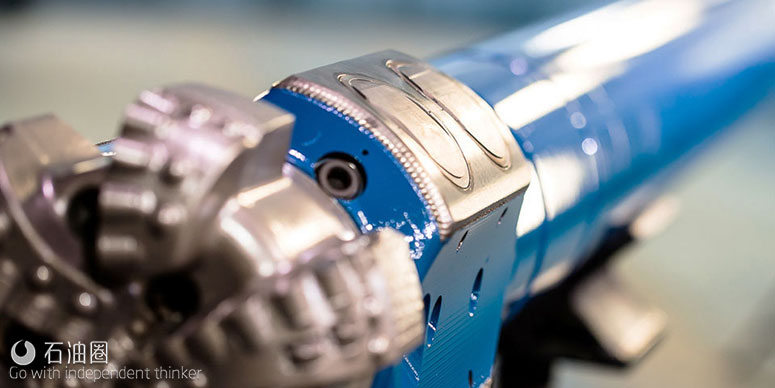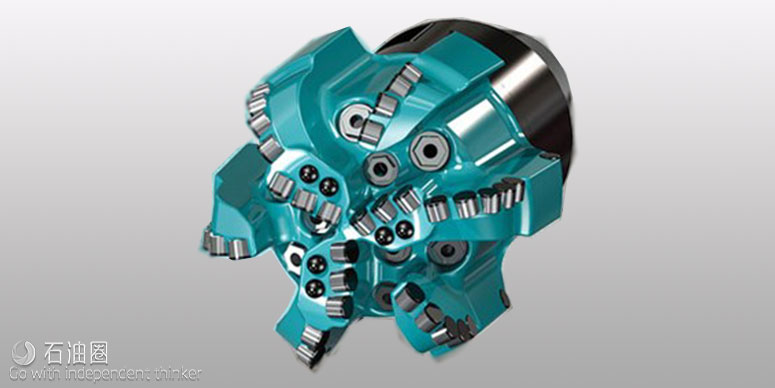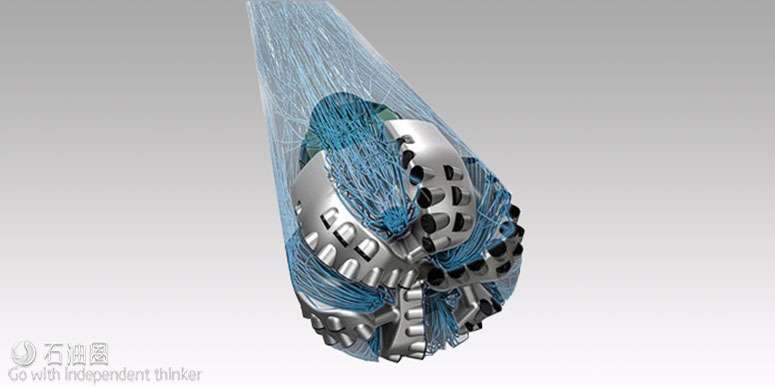IMPROVED CUTTINGS EVACUATION
Ulterra Drilling Technologies’ latest innovation is the patent-pending SplitBlade PDC bit (Fig. 4) that is increasing ROP and reducing drilling time with reconfigured cuttings evacuation, cutter cleaning, and bit cooling.
Typically, with most PDC technology, recirculated rock cuttings become trapped at the toolface, and the build-up clogs the junk slots. Trying to recut old cuttings that should have been evacuated quickly wastes energy, in addition to degrading the bit.
The company’s research team examined the physical restraints of a basic PDC drill bit. The engineers proposed a new pattern that would maintain the cutters in a cleaner, cooler state. The improved thermal management of the bit face would support the goal of extending bit durability and lead to higher performance.
Using CFD, the team created a distinctive bit body, with new blade geometry, nozzle placement, and cutter layout. By splitting the shape of the primary blades with an angular offset, designers created designated flow channels for the fluid and cuttings. Two nozzles are positioned to support the cutters in the critical area to capitalize on this advancement in bit body construction and hydraulic control. While drilling, cuttings from SplitBlade technology can be evacuated up to seven times faster, compared with conventional designs.
Case studies. In the LaSalle County portion of the Eagle Ford shale in South Texas, an operator was experiencing poor cuttings removal and plugged nozzles. To solve the issues, an 8?-in. SplitBlade PDC was run, and it drilled the curve 27% faster than offsets. This run set a company formation footage record of nearly 14,000 ft, MD, for the curve and lateral. The ROP of more than 150 ft/hr was 8% faster than the offset average in wells over 10,000 ft.
In the eastern Eagle Ford, another operator wanted to reduce the instances of nozzle plugging to improve ROP, and selected an 8?-in. SplitBlade bit. The plan was to improve lateral and overall ROP with better directional control and cuttings removal. The bit was run, and it set a rig footage and ROP record, drilling the lateral at 400 ft/hr instantaneously and, overall, just less than 12,000 ft in under 68 hr. The average ROP of 172 ft/hr was 56% faster than the average run on this rig.
HYDRAULICS FOR SOFT FORMATIONS
Precise, application-specific optimization of PDC bit hydraulics has improved drilling performance in vertical and lateral Permian basin wells. Using curved nozzles, webbed blades, and proprietary design features, Varel Oil & Gas Drill Bits’ HYDRA hydraulics optimization program (Fig. 5) has improved ROP and footage drilled in softer clays and shale, as well as sands and limestone. In a Wolfcamp lateral, an optimized bit increased ROP 58% and footage by 98%.
The HYDRA program improves performance with better bit cooling and cleaning, and more effective cuttings removal. The design process applies uniquely curved nozzles, webbed blades, and other features using CFD to match the design to the application. The curved nozzles reduce core-outs, plugged nozzles, and bit balling. The webbed blades limit cuttings recirculation, reduce entrainment, and increase cuttings volume.
Rig capabilities
Cuttings volume, formation types and rig pressure limitations can greatly reduce the hydraulics performance of PDC bits. In these applications, improving cleaning efficiency is difficult without trading a drop in pressure across the bit. Different methods have been used, in an attempt to improve fluid velocity and impact pressure, with varying degrees of success.
Varel’s research led to extensive modeling to reproduce the effect and advantages of various curved nozzle designs that could be applied across an entire size range of bits. This required CFD studies to understand the results of each change in nozzle configuration, and how the nozzle redirects flow and velocity across the bit.
Using results from the CFD modeling, the company optimized a unique set of features, including proprietary curved nozzles, webbed blades, and other design characteristics. The program successfully balances traditional trade-offs to optimize performance in specific applications.
Curved nozzles
The curved nozzles produce several actions that enhance performance. Bit stability is improved, and formation erosion is mitigated, because the fluid stream’s impact on the formation is reduced. Fluid flow is, instead, directed to the cutter surface to improve cleaning and cooling without affecting rig hydraulics. This reduces coring and other problems to extend bit life.
The webbed blade feature blocks fluid flow to adjacent junk slots to prevent cuttings recirculation. It also eliminates fluid entrainment by adjacent nozzles to maximize nozzle efficiency. The unique junk slot geometry results in more efficient cleaning for greater cuttings removal.
Permian basin performance
In New Mexico, interbedded clays, carbonates, limestones and sandstones typically challenge PDC bit penetration rates and footage. Bit hydraulics are particularly important to efficiently drilling the target intervals. An 8?-in. PDC bit that was optimized for the application significantly improved footage, drilling a 7,001-ft vertical section, compared to an offset average of 6,579 ft. ROP was faster at 133 ft/hr versus the 106 ft/hr average offset performance. These results produced the operator’s fastest one-BHA run to TD.
On the Texas side of the basin, HYDRA optimization has cut the number of bits in half. Only two 61/8-in. bits were required to drill a lateral section that typically has required four bits. They drilled 8% more footage at an 8.5% higher ROP, compared to standard PDC bits used in offsets, eliminating the time cost, and risk of two additional round trips.

 石油圈
石油圈


